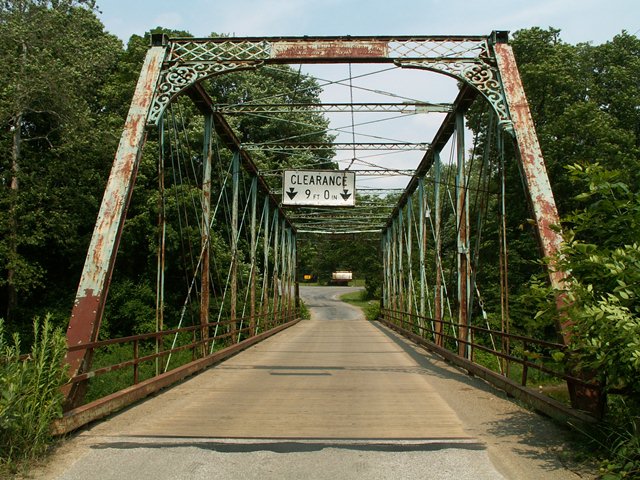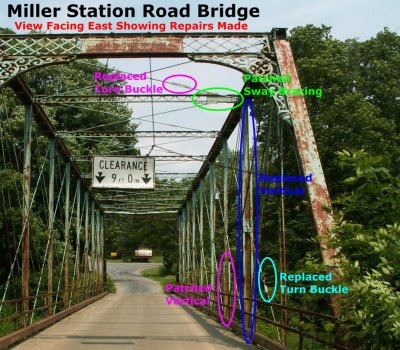We Recommend:
Bach Steel - Experts at historic truss bridge restoration.
Miller Station Road Bridge

Primary Photographer(s): Nathan Holth
Bridge Documented: July 1, 2006
Rural: Crawford County, Pennsylvania: United States
Metal 10 Panel Pin-Connected Whipple (Double-Intersection Pratt) Through Truss, Fixed
1887 By Builder/Contractor: Wrought Iron Bridge Company of Canton, Ohio
1941
132.0 Feet (40.2 Meters)
136.0 Feet (41.5 Meters)
16.7 Feet (5.09 Meters)
1 Main Span(s)
201016007018930

View Information About HSR Ratings
Bridge Documentation
This bridge no longer exists!
View Archived National Bridge Inventory Report - Has Additional Details and Evaluation
This historic cast and wrought iron bridge was demolished and replaced by PennDOT in 2011!
View A Historical Narrative Prepared By PennDOT As Mitigation For Demolition
About This Bridge
This impressive bridge was built by the Wrought Iron Bridge Company according to an 1875 patent, as the builder plaque indicated. 1887 was the date given by the Historic Bridge Inventory for the construction of the bridge. The bridge was a good example of the double-intersection Pratt truss configuration, also known as a Whipple truss and which is a rare and highly significant truss configuration in Pennsylvania. It was also noted as an example of one of the earlier designs used by the Wrought Iron Bridge Company. The wrought iron bridge was also significant for its used of cast iron in selected areas on the bridge. The bridge featured a number of distinctive details that the Wrought Iron Bridge Company used. The lacy, ornate cast iron portal knee bracing on the bridge was similar to the bracing on Michigan's Maple Road Bridge. The vertical members were an unusual design Wrought Iron Bridge Company used on many of its earlier truss bridges, but was unlike those used by other bridge companies. The Historic Bridge Inventory mentioned that the verticals were not original, which appears to have been incorrect. Instead, only one vertical member on the bridge appeared to have been replaced. Around this replaced vertical a number of other repairs had also taken place. It is likely the bridge was damaged from a car hitting it. Another less likely possibility is that debris from a flood damaged the bridge resulting a in a need for repairs.
The weight of the existing bridge was calculated by engineers as follows: Left Truss - 14,000 lbs. Right Truss - 14,000 lbs. Upper Lateral System and Floor System - 16,500lbs. Total - rounded up to 45,000 lbs.
An Indescribable Loss
Despite the fact that a bridge like the Miller Station Bridge could likely have been rehabilitated to provide many more decades of safe, reliable service life for less than the cost of replacement, this bridge was demolished and replaced by PennDOT. Despite the fact that the bridge was a beautiful and extremely rare example of a Whipple truss in Pennsylvania, this bridge was demolished and replaced by PennDOT.
That a cast and wrought iron Whipple truss that survives in the 21st Century would even be considered for demolition is an atrocity. To actually allow it to occur is an unspeakable injustice against history. At the absolute minimum, the bridge should have been dismantled and placed into storage for future reuse. The bridge could have been relocated and reused on a trail for non-motorized vehicles.
Mitigation for the replacement of this bridge was unacceptable. A historical narrative available above was produced. While it does provide information that may be of use, high school students could be expected to produce something larger and more detailed. Furthermore, if you read the historical narrative prepared for PennDOT as mitigation for demolition, you will find a self-fulfilling prophecy in the conclusion:
"Although they are deteriorating and most, in all likelihood, will eventually be lost, Pennsylvania's wrought iron Whipple truss highway bridges have served the traveling public for nearly a century and a half. They stand witness to the durability of wrought iron as a structural material, and to the ingenuity and dedication of the men who designed and built them."
If the bridges are lost, PennDOT has nobody to blame but itself. Indiana has managed to preserve many of its historic Whipple truss bridges, both for vehicular and pedestrian use. As much as Pennsylvania's Whipple truss bridges were a "witness to the durability of wrought iron" and "the ingenuity and dedication of the men who designed and built them" their demolition is a testimony to the shortsightedness of highway agencies in Pennsylvania, that were incapable of preserving extremely rare historic bridges that could have been rehabilitated to provide decades of additional service life.
Information and Findings From Pennsylvania's Historic Bridge InventoryDiscussion of Bridge The only observed recent change was the in kind replacement of the timber deck. The verticals are not original, but it is not known when they were replaced. Bridge Considered Historic By Survey: Yes |
![]()
Photo Galleries and Videos: Miller Station Road Bridge
Bridge Photo-Documentation
Original / Full Size PhotosA collection of overview and detail photos. This gallery offers photos in the highest available resolution and file size in a touch-friendly popup viewer.
Alternatively, Browse Without Using Viewer
![]()
Bridge Photo-Documentation
Mobile Optimized PhotosA collection of overview and detail photos. This gallery features data-friendly, fast-loading photos in a touch-friendly popup viewer.
Alternatively, Browse Without Using Viewer
![]()
Maps and Links: Miller Station Road Bridge
This historic bridge has been demolished. This map is shown for reference purposes only.
Coordinates (Latitude, Longitude):
Search For Additional Bridge Listings:
Bridgehunter.com: View listed bridges within 0.5 miles (0.8 kilometers) of this bridge.
Bridgehunter.com: View listed bridges within 10 miles (16 kilometers) of this bridge.
Additional Maps:
Google Streetview (If Available)
GeoHack (Additional Links and Coordinates)
Apple Maps (Via DuckDuckGo Search)
Apple Maps (Apple devices only)
Android: Open Location In Your Map or GPS App
Flickr Gallery (Find Nearby Photos)
Wikimedia Commons (Find Nearby Photos)
Directions Via Sygic For Android
Directions Via Sygic For iOS and Android Dolphin Browser
USGS National Map (United States Only)
Historical USGS Topo Maps (United States Only)
Historic Aerials (United States Only)
CalTopo Maps (United States Only)


